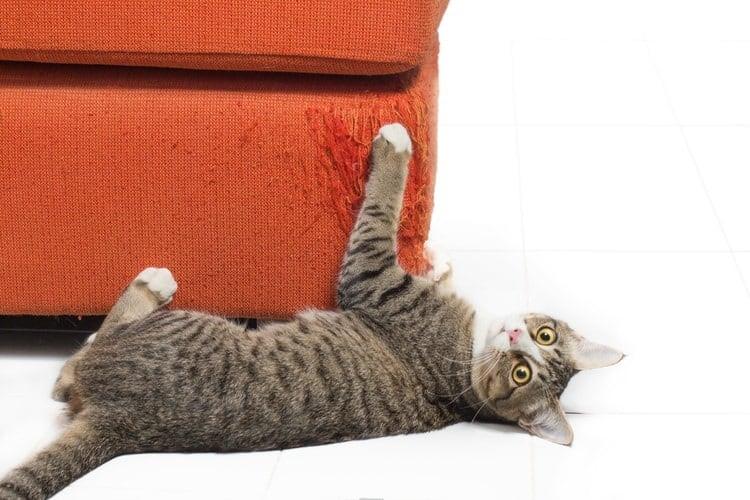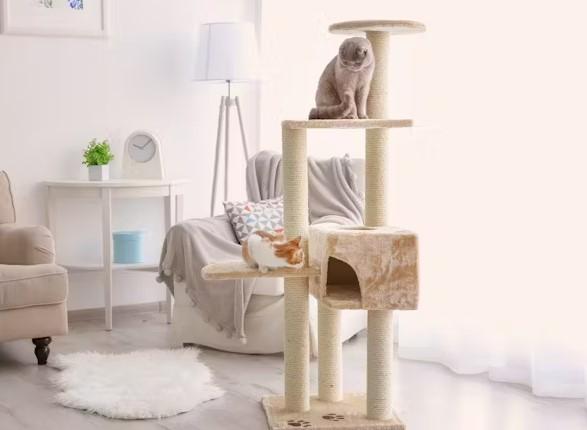Understanding and Managing Cat Scratching Behavior in the Home

Cat scratching is a natural and instinctual behavior that serves several important purposes for our feline companions. However, when it starts to affect our furniture and belongings, it can become a source of frustration for cat owners. In this article, we'll explore why cats scratch, how to manage this behavior, and provide tips for protecting your home.
Scratching indoors may indicate that the cat does not feel completely secure in its surroundings. In order to stop this destructive behaviour the owner must first understand why their cat is scratching in the house.

What is scratching?
Cats scratch objects for two reasons; to maintain good condition of their claws and to leave a message in that location. When the claws are dragged down a surface, a smell, which is unique to the individual, is deposited on the surface. This scent and the visual signal of the scratch marks and discarded claw husks provide a strong message to other cats, as well as to the cat itself.
Why does my cat scratch indoors?
Noting where your cat is scratching. This might help you figure out why it is itching.
Many cats don't have much or any access to the outdoors, so they have to keep their claws in good shape inside. To do this, a cat will choose one or two good places to scratch and only use those. Cats like to scratch on things that are tall, strong, and have a vertical weave. Unfortunately, the back of the sofa often works much better than most commercial scratching posts.
Cats that like being petted a lot or cats that don't have enough to do at home might also learn that when they scratch the furniture or walls, their owners pay attention to them, but when they use their scratching post, they are ignored. This is why they keep scratching on inappropriate objects to get your attention.
But if the scratch marks are found all over the house, especially in places where cats and people often fight, like doors and windows, it's more likely that the cat is scratching to communicate because it feels unsafe in those places. Having another cat around is the most common reason for this kind of scratching, but other changes in the surroundings can also cause it.
.
The Purpose of Scratching
Scratching is an integral part of a cat's life for the following reasons:
-
Nail Maintenance: Scratching helps cats shed the outer layers of their claws, keeping them healthy and sharp.
-
Stretching and Exercise: It allows cats to stretch their bodies and flex their muscles, promoting overall physical health.
-
Territorial Marking: Cats have scent glands in their paws, and by scratching, they leave both a visual and olfactory mark on their territory.
-
Stress Relief: Scratching can be a way for cats to relieve stress or anxiety, providing a form of emotional comfort.

Understanding Your Cat's Preferences
Not all cats have the same scratching preferences. Some may prefer vertical surfaces like scratching posts, while others may favor horizontal surfaces like carpets. It's important to observe your cat's behavior and provide scratching options that align with their preferences.
How can I stop my cat scratching indoors?
If your cat scratches furniture or wallpaper to keep its claws in good shape, you should put a thick piece of plastic over the scratched area to stop the cat from scratching there again. Then, put a good scratching post right next to the spot that was scratched. Cats should be able to fully stretch out while scratching, and the best scratching posts should have a heavy base that gives them enough resistance. The posts should also have a vertical weave that lets the cat drag its claws downwards without getting caught. Putting tasty treats on this new post and giving your cat praise every time it uses it will help it learn to use it. Once the cat is regularly using the new post, its owner can slowly move it to a better spot and take off the plastic covering from the safe area.
If you think your cat is marking its territory by scratching furniture, you need to figure out what is making it nervous in that area and fix it. Just stopping your cat from scratching isn't enough; this behavior is a sign that your cat is stressed. You might be able to figure out what is bothering your cat by looking at where it scratches. For example, if your cat scratches inside doors or other places where other cats have to go by often, that cat might feel threatened by the other cats. The cat is more likely to be scared of something outside, like a neighboring cat coming into the yard, if it scratches at doorways and window frames that are on the outside.
You must deal with your cat's anxieties in order for it to feel more secure in its surroundings and to permanently stop its motivation to scratch the furniture. In addition to reducing your cat's stress, you can also encourage scratching on an appropriate surface. Cover the scratched area with a protective material and place a more appropriate scratching surface next to it.
Managing Cat Scratching in the Home
-
Provide Appropriate Scratching Surfaces:
- Invest in a variety of scratching posts and pads made of different materials (sisal, cardboard, etc.).
- Place them strategically in areas where your cat likes to scratch.
-
Cat-Friendly Furniture:
- Consider purchasing furniture designed for scratching, like cat trees or condos that incorporate scratching surfaces.
-
Training and Positive Reinforcement:
- Encourage your cat to use their designated scratching surfaces by rewarding them with treats or praise when they do so.
-
Deter Unwanted Scratching:
- Use double-sided tape, aluminum foil, or commercial deterrent sprays on surfaces you want to protect.
-
Regular Nail Trimming:
- Keeping your cat's nails trimmed can help reduce the damage caused by scratching.
-
Provide Mental and Physical Stimulation:
- Engage your cat in interactive play sessions to help release excess energy and reduce stress.
-
Use Soft Nail Caps:
- Soft nail caps can be applied to your cat's claws to prevent them from causing damage during scratching.
-
Monitor for Stress or Anxiety:
- If your cat's scratching behavior suddenly increases, it could be a sign of underlying stress or anxiety. Consult a vet for guidance.
Avoid Punishment
It's important to remember that punishing your cat for scratching is not effective and can lead to increased stress and anxiety. Instead, focus on providing positive reinforcement for desired behaviors.
Further help
This advice will cure most cases of indoor scratching; however, in some cases the problem is too complex for owners to address without help. It may then be necessary to ask your vet for a referral to a clinical behaviourist.
Conclusion
Understanding why cats scratch and providing appropriate outlets for this behavior is crucial for maintaining a harmonious relationship with your feline friend. By offering a variety of scratching options and creating a stimulating environment, you can help your cat satisfy their natural instincts without causing damage to your home.





